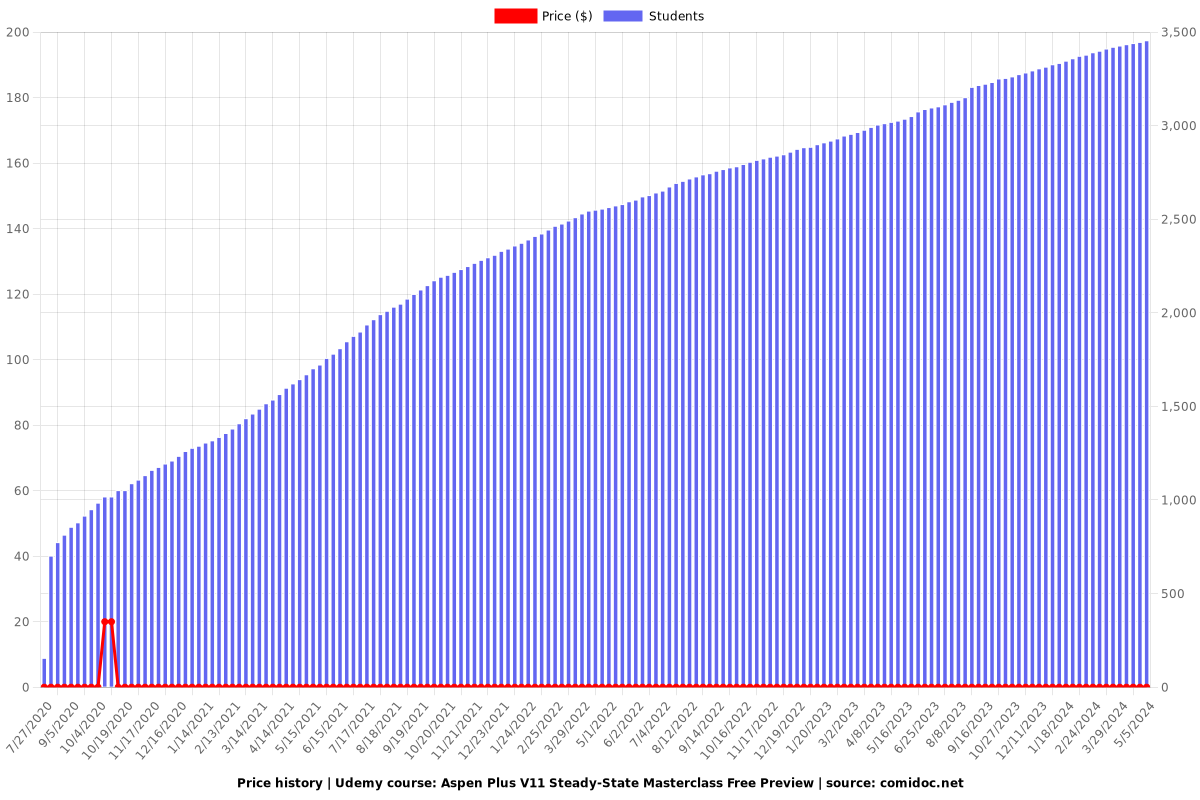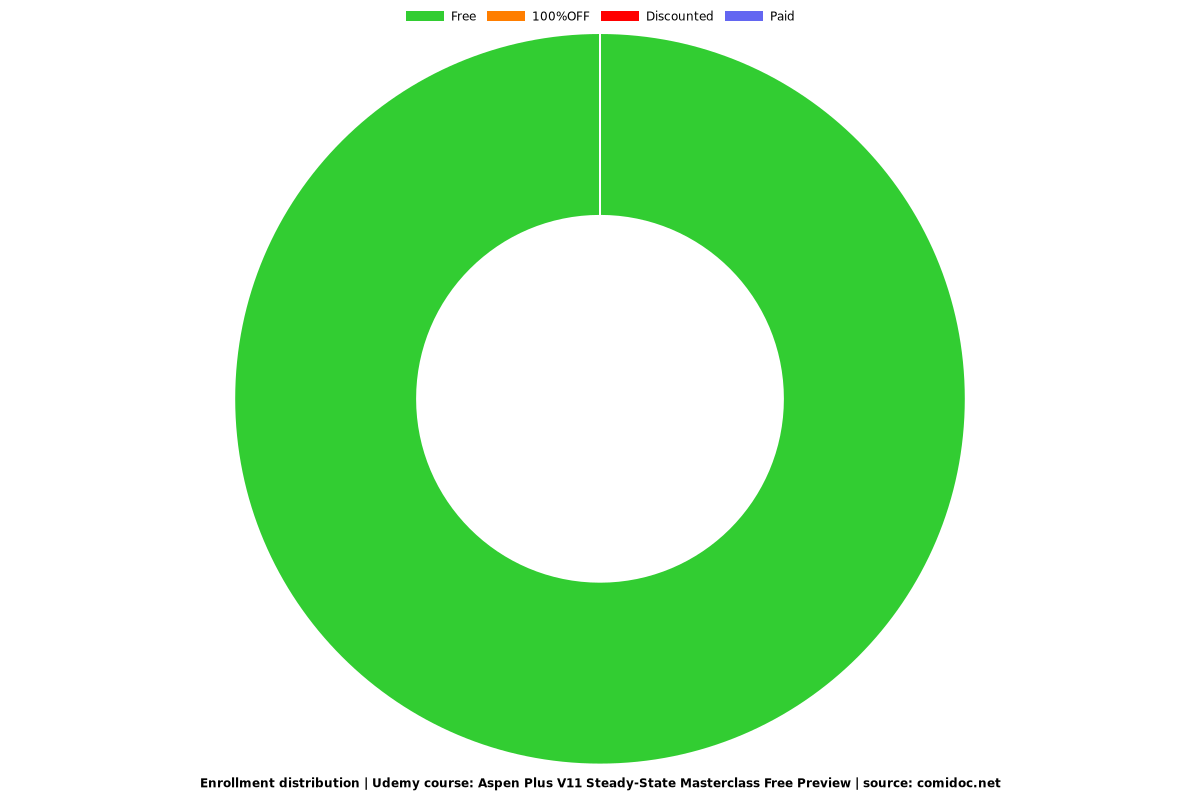Aspen Plus V11 Steady-State Masterclass Free Preview
Steady-State Chemical Engineering Simulation and Process Modeling using Aspen Plus V11

What you will learn
Identify the benefits of process simulation using Aspen Plus
Describe the capabilities of Aspen Plus
Familiarize yourself with Aspen Plus graphical user interface and organizational structure
Learn the basic concepts necessary for creating simulations in Aspen Plus
Enter necessary elements to fully define a Fluid Package
Select the appropriate property method for your application
Define material streams and connect unit operations to build a flowsheet
Modify and set desired units of measure
Review stream analysis options
Add and connect unit operations to build a flowsheet
Use the Report Manager to create custom unit operation and stream reports
Use Aspen Plus to perform property analysis of pure components and mixtures
Use Aspen Plus in thermodynamics instruction for Vapor-Liquid, Liquid-Liquid and Vapor-Liquid-Liquid Equilibrium calculations
Build, navigate and optimize steady state simulation models using Aspen Plus
Utilize a wide variety of unit operation models and calculation tools to model process equipment
Evaluate the performance of existing equipment by leveraging the equipment rating capabilities of Aspen Plus
Perform Case Studies to determine the optimum operating points for a process
Design, revamp and debottleneck process equipment
Use the Model Analysis Tools to run sensitivity analysis and optimize your process
Calculate process performance and thermophysical data with user subroutines in Fortran
Investigate reasons why a simulation may produce poor results or errors
Use suggested tips to debug a variety of simulations
Understand best practices and learn how to troubleshoot simulations
Identify and explain the various classes of distillation and separations models available in Aspen Plus
Gain the skills and knowledge to model distillation, separation and extraction processes
Reduce process design time by using advanced features of RadFrac distillation columns
Use column analysis tools to optimize the feed location and number of stages and improve energy utilization for distillation columns
Add and manipulate column specifications to meet process objectives
Construct, run, manipulate and analyze a distillation column
Specify required parameters in order to execute flash calculations and fully define material streams
Identify and explain the various classes of reactor models available in Aspen Plus (PFR, CSTR…)
Model Plug Flow, Continuous Stirred Tank and Fluidized Bed Reactors
Enter reaction stoichiometry and kinetic data for simple (POWERLAW) and complex (LHHW) reaction types
Use the Model Analysis Tools to run sensitivity analysis and optimize the operating conditions of a chemical reactor
Use the Model Analysis Tools to run sensitivity analysis and optimize the selectivity of a given chemical reaction
Identify and explain the various classes of piping system models available in Aspen Plus (pipes, valves, pumps, compressors)
Model piping components (pipes, fittings, valves...)
Model fluid movers (pumps, compressors)
Model piping systems
Mitigate the risk for cavitation or choked flow using Aspen Plus
Learn how to economically optimize your piping system
Compare and contrast the applicability and operation of different heat exchanger models available in Aspen Plus
Learn the fundamentals of producing an optimized shell & tube heat exchanger design
Implement Aspen Exchanger Design & Rating (EDR) for rigorous heat exchanger calculations within Aspen Plus
Use the Activated Exchanger Analysis feature for continuous heat exchanger study and design
Design and rate a shell and tube heat exchanger using the EDR interface inside Aspen Plus
Identify and explain the various classes of solids and solids separator models available in Aspen Plus
Gain the practical skills and knowledge to begin modeling new and existing solids processes (crushers, fluidized beds, dryers, crystallizers…)
Learn practical techniques for building and troubleshooting solids models
Why take this course?
---- PLEASE READ CAREFULLY THE NOTES BELOW BEFORE ENROLLING IN ----
This is a 30 min FREE preview of our Aspen Plus Masterclass. This is NOT the full version of the course.
These FREE video samples are intended to ONLY give you an overview of the course.
If you are looking to take your Aspen Plus skills to the next level, we encourage you to watch carefully these FREE videos and check out the Aspen Plus Masterclass Catalog available in the downloadable resource section at the end of this FREE preview.
The full Aspen Plus Masterclass is designed to help you become an Aspen Plus Advanced User if that is what you like and persist to be.
For more details about the full version of the course, please watch the FREE video samples and check the downloadable resources.
Thank you for your interest in our courses.
Looking forward to hearing from you.
WR Training
Spread the wings of your knowledge
------------------------------
ASPEN PLUS MASTERCLASS - FULL COURSE DESCRIPTION :
Aspen Plus is a powerful engineering simulation software that you can use to model a wide range of chemical processes.
It is widely used in engineering universities and in the industry, in research, development, modeling and design.
Aspen Plus serves as the engineering platform for modeling processes from Upstream through Gas Processing to Petroleum Refining, Petrochemicals, Chemicals and Pharmaceutical processes.
Online courses about Aspen Plus are difficult to find and when you find them they are either expensive or not professional.
This unique online course is designed around a series of chemical process examples which we work through to a model solution. It is an essential guide to understanding the principles, features and functions of Aspen Plus. This understanding is a prerequisite for a successful design, simulation, rating & optimization of your plant and process equipment.
This unique online course leads you through a process that becomes continuously more difficult, challenging and enriching. When the course content and practice sessions have been completed, we expect that you will have become a competent and advanced user of Aspen Plus.
The course is built with over 9 sections, each tackling a different chemical process and a different aspect of Aspen Plus :
Introducing Aspen Plus
Flash Separation & Distillation Columns
Liquid-Liquid Extraction processes
Heat Exchangers
Piping Systems
Chemical Reactors
Solids Handling processes
Aspen Plus Model Analysis Tools
Aspen Plus Safety Analysis Environment (Bonus section)
The first section explains the basic structure of the software and leads you through a hands-on introduction to the various features of Aspen Plus, designed to facilitate the set up of simple problems.
Features such as the material balance, access to Aspen Plus documentation, the “Next” button, menu navigation, Properties and simulation environments, and the report function are introduced.
The remainder of the course is organized in a series of sections that focus on particular types of operations and processes, for example : chemical reactors, heat exchangers or piping systems.
Each section describes the process being modeled, the way it is modeled, the equations being solved, the various limitations, the potential sources of error, and a set of workshops containing exercises that you should solve to gain experience with the particular subject.
So in just about 14 hours, this unique online course will make you an advanced Aspen Plus user and you will learn how to :
Build, navigate and optimize steady state simulation models using Aspen Plus
Utilize a wide variety of unit operation models and calculation tools to model your process equipment such as distilling columns, reactors, pumps, compressors and piping systems just to name a few
Then Evaluate the performance of your existing equipment by leveraging the equipment rating capabilities of Aspen Plus
Perform Case Studies to determine the optimum operating points for your process
Use the Model Analysis Tools to run sensitivity analysis and optimize your process
And finally Use Aspen Plus in thermodynamics instruction for property analysis of pure components and mixtures
The knowledge gained in this course will set you apart from your peers, whether you are a graduate student, a practicing chemical engineer, or a manager, and will give you an edge over your competitors when seeking employment at industrial facilities.
So with no further ado, check out the free preview videos and the curriculum of the course and we look forward to seeing you in the first section.
Hope to see you there
WR Training
Spread the wings of your knowledge
------------------------------
IMPORTANT NOTES :
This course is built with over 9 sections, each tackling a different chemical process and a different aspect of Aspen Plus. Feel free to jump to the sections that most interest you especially if you're a little bit more advanced. If you're starting from scratch or even if you're not, we do highly recommend starting from the beginning.
Aspen Plus is a complex process simulator and, in our opinion, the best way to learn is with hands-on experience, by attempting each example provided in this online course, and when difficulties are encountered, by referring to the problem setup and solution that you can find in the downloadable resource section.
The downloadable resources contain the input and solutions to all of the examples and workshops covered in this online course. There is a root folder for each section, within which, there are subfolders named Examples. Each example is provided in .bkp Aspen Plus format and .txt format. The .bkp files are set up as input files to view details and may be executed. The .txt files are solutions and may be viewed with Notepad. We recommend that while reading the text, Aspen Plus be used simultaneously to execute and review each example.
Lastly, we have made an effort to provide the describing equations of most of the models referred to in this online course and if not possible, because of the proprietary nature of the software, we have described the functionality. Please keep in mind that Aspen Plus is a proprietary software and the source code and implementation details are not available. Additionally, there are frequently several ways to solve the equations that describe the blocks, and there is no way to ascertain these details since Aspen Technology does not provide them.
------------------------------
SOFTWARE & HARDWARE :
The Aspen Plus software, like most other software, is being developed on a continuous basis and new versions are released frequently. This online course covers Aspen Plus version 11, which is the most recent version at the moment we recorded this video. Please keep in mind that this online course covers the fundamental features of Aspen Plus which do not change from version to version. The course covers the use of Aspen Plus on computers that use the Windows operating system. We assume that Aspen Plus is installed on your computer and that you have basic knowledge of operating the computer. If you are new to Aspen Plus and have little or no experience in chemical engineering simulation, then you have come to the right place.
Reviews
Charts
Price

Rating

Enrollment distribution
